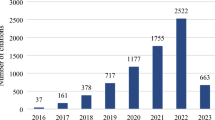Abstract
Following recent attempts to find appropriate choices for parameter of the nonlinear conjugate gradient method proposed by Dai and Liao, two adaptive versions of the method are proposed based on a matrix analysis and using the memoryless BFGS updating formula. Under proper conditions, it is shown that the methods are globally convergent. Numerical experiments are done on a set of CUTEr unconstrained optimization test problems; they demonstrate the efficiency of the proposed methods in the sense of Dolan–Moré performance profile.


Similar content being viewed by others
References
Andrei N (2007) Numerical comparison of conjugate gradient algorithms for unconstrained optimization. Stud Inform Control 16(4):333–352
Andrei N (2011) Open problems in conjugate gradient algorithms for unconstrained optimization. Bull Malays Math Sci Soc 34(2):319–330
Babaie-Kafaki S (2014) An adaptive conjugacy condition and related nonlinear conjugate gradient methods. Int J Comput Methods 11(4):1350092
Babaie-Kafaki S (2016) On optimality of two adaptive choices for the parameter of Dai-Liao method. Optim Lett 10:1789–1797
Babaie-Kafaki S, Ghanbari R (2014a) The Dai-Liao nonlinear conjugate gradient method with optimal parameter choices. Eur J Oper Res 234(3):625–630
Babaie-Kafaki S, Ghanbari R (2014b) A descent extension of the Polak-Ribière-Polyak conjugate gradient method. Comput Math Appl 68(12):2005–2011
Babaie-Kafaki S, Ghanbari R (2014c) A descent family of Dai-Liao conjugate gradient methods. Optim Methods Softw 29(3):583–591
Babaie-Kafaki S, Ghanbari R (2015) Two optimal Dai-Liao conjugate gradient methods. Optimization 64(11):2277–2287
Dai YH, Han JY, Liu GH, Sun DF, Yin HX, Yuan YX (1999) Convergence properties of nonlinear conjugate gradient methods. SIAM J Optim 10(2):348–358
Dai YH, Kou CX (2013) A nonlinear conjugate gradient algorithm with an optimal property and an improved Wolfe line search. SIAM J Optim 23(1):296–320
Dai YH, Liao LZ (2001) New conjugacy conditions and related nonlinear conjugate gradient methods. Appl Math Optim 43(1):87–101
Dai Z, Chen X, Wen F (2015) A modified Perry’s conjugate gradient method-based derivative-free method for solving large-scale nonlinear monotone equations. Appl Math Comput 270(7):378–386
Dai Z, Li D, Wen F (2016) Worse-case conditional value-at-risk for asymmetrically distributed asset scenarios returns. J Comput Anal Appl 20(2):237–251
Dolan ED, Moré JJ (2002) Benchmarking optimization software with performance profiles. Math Program 91(2, Ser. A):201–213
Dong XL, Liu H, He Y (2015) A self-adjusting conjugate gradient method with sufficient descent condition and conjugacy condition. J Optim Theory Appl 165(1):225–241
Gould NIM, Orban D, Toint PhL (2003) CUTEr: a constrained and unconstrained testing environment, revisited. ACM Trans Math Softw 29(4):373–394
Hager WW, Zhang H (2005) A new conjugate gradient method with guaranteed descent and an efficient line search. SIAM J Optim 16(1):170–192
Hager WW, Zhang H (2006a) Algorithm 851: \(CG\_Descent\), a conjugate gradient method with guaranteed descent. ACM Trans Math Softw 32(1):113–137
Hager WW, Zhang H (2006b) A survey of nonlinear conjugate gradient methods. Pac J Optim 2(1):35–58
Perry A (1976) A modified conjugate gradient algorithm. Oper Res 26(6):1073–1078
Powell MJD (1984) Nonconvex minimization calculations and the conjugate gradient method. In: Griffiths DF (ed) Numerical analysis (Dundee, 1983) volume 1066 of Lecture Notes in Math. Springer, Berlin, pp 122–141
Sun W, Yuan YX (2006) Optimization theory and methods: nonlinear programming. Springer, New York
Watkins DS (2002) Fundamentals of matrix computations. Wiley, New York
Wen F, He Z, Dai Z, Yang X (2014) Characteristics of investors’ risk preference for stock markets. Econ Comput Econ Cybern 48(3):235–254
Xu C, Zhang JZ (2001) A survey of quasi-Newton equations and quasi-Newton methods for optimization. Ann Oper Res 103(1–4):213–234
Acknowledgements
The authors are grateful to Professor William W. Hager for providing the line search code. They also thank the anonymous reviewer for his/her valuable suggestions helped to improve the presentation.
Author information
Authors and Affiliations
Corresponding author
Rights and permissions
About this article
Cite this article
Babaie-Kafaki, S., Ghanbari, R. Two Adaptive Dai–Liao Nonlinear Conjugate Gradient Methods. Iran J Sci Technol Trans Sci 42, 1505–1509 (2018). https://doi.org/10.1007/s40995-017-0271-4
Received:
Accepted:
Published:
Issue Date:
DOI: https://doi.org/10.1007/s40995-017-0271-4




